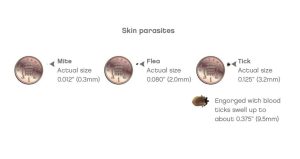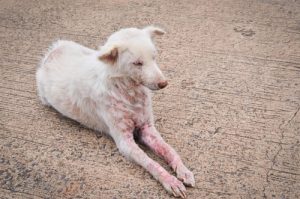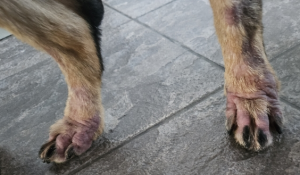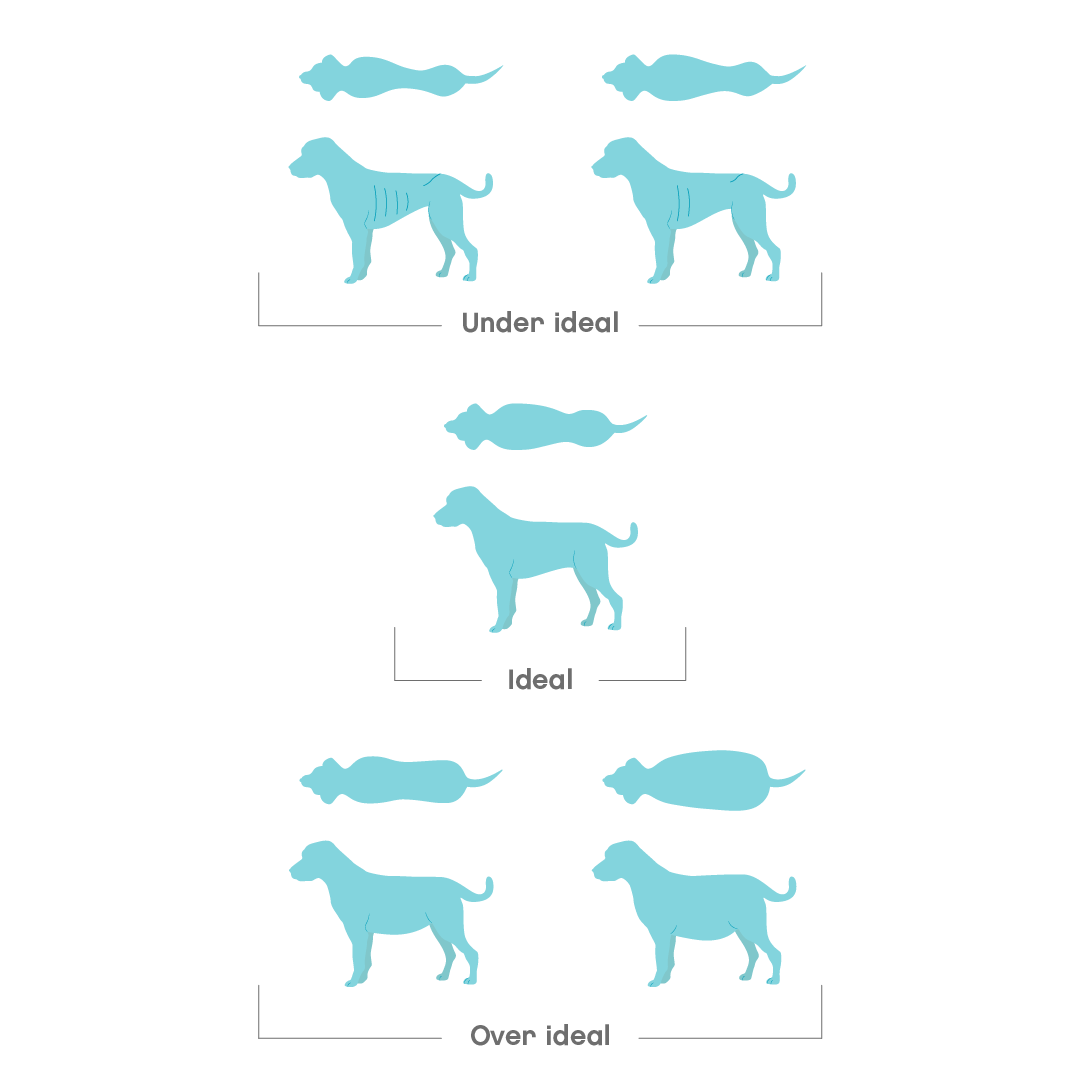Mange can affect dogs of any age, gender, or breed. Younger dogs tend to recover quickly from a mange infection. Long-term treatment may be necessary for older dogs. The symptoms of mange can range from very mild to very severe. From a few patches of hair loss to severe itching and bacterial skin infections.
Most dogs have no long-lasting effects after a mange infection. Sometimes the hair can take a while to grow back, but the other symptoms tend to clear quickly.
Overview
What is mange in dogs?
Mange is a parasitic skin disease caused by tiny mites, which are invisible to the eye. They live under the surface of the skin and in the hair follicles.

Mange is caused by two different types of mites: Sarcoptes and Demodex.
How do dogs get mange?
Demodex/Demodicosis
- Demodex doesn’t usually spread between dogs but can pass from mother to pup during nursing.
- It usually affects dogs that have a weakened immune system. This includes dogs that are elderly, very young, or have other health problems.
- Demodectic mange can be localised, generalised, or affect the paws. The localised form is most common in puppies. The type that affects the paws can be the most difficult to treat.
- Demodex is sometimes referred to as “red mange” because the skin looks red and inflamed.
Sarcoptes/Scabies
- Scabies is highly contagious and spreads through direct contact with other dogs. It also spreads on objects such as shared bedding.
- It’s known as fox mange, as it is also spread by foxes.
- Scabies can transfer to humans, but the mites cannot live on the skin for very long.
If left untreated, both types of mange can lead to a secondary bacterial infection in the skin. Our Joii team are available 24 hours a day for advice.
Symptoms
Symptoms of mange in dogs
Dogs may develop one or more of the following signs with mange
- Hair loss can be one of the early stages
- Itching ranges from mild to severe
- Red, inflamed, crusty, or scabby skin
- Thickened skin
- Enlarged lymph nodes
- Lethargy
Sarcoptic mange
- Usually begins in hairless areas around the ears, armpits, and tummy. It can spread all over the body.

Demodectic mange
- Localised; this often starts around the eyes and face and isn’t usually itchy.
- Generalised; lesions all over the body.
- Pododermatitis; affects the paws.


Risk
Are some dogs at greater risk of mange than others?
- Dogs with weaker immune systems are more at risk. This includes dogs that are elderly, very young, or those with other underlying health issues, such as diabetes or cancer.
- Some breeds have an increased risk of demodex. These include Shar-Pei, Shih Tzu, West Highland White Terrier, Pug, Boxer, Border Terrier, and Bull breeds.
Can humans catch mange from dogs?
- Sarcoptic mange can spread to other dogs, cats, and even humans.
- The symptoms in humans are usually very mild, as the mites cannot live on the skin for long.
- The main symptom is itching. We recommend speaking to your GP to discuss whether you need treatment.
Diagnosis
How is mange in dogs diagnosed?
- Your vet will usually diagnose mange based on the way the symptoms appear and by looking at scrapings of the skin under a microscope.
- Mites may also be found on a hair pluck sample or skin biopsy.
- Some types of mange are difficult to diagnose. Your vet may do a medication trial even if the skin tests are negative.
Vet treatment
What’s the treatment for mange in dogs?
- The localised form of demodex in puppies sometimes clears without any medication.
- Medication to treat and kill the mites usually comes as a tablet or spot-on. This is only available from your local vet, as it is a prescription drug. Over-the-counter products are not effective against mites. Repeated doses for several months are often required.
- Oral antibiotics, shampoos, or creams for any secondary bacterial skin infection.
- Anti-itch or anti-inflammatory medication.
- The cost of treatment for mange in the UK can vary. If caught and treated early, the costs will usually be lower. If a secondary skin infection is present, then extra medication will increase costs.
Your vet might also perform tests to check for underlying health conditions such as Cushing’s disease, hypothyroidism, kidney disease, liver disease, and allergic or auto-immune skin conditions.
Home treatment
Home treatment if your dog has mange
Demodex
Demodex is not contagious in dogs. We recommend routine cleaning of all toys, bedding, and collars.
Sarcoptes
This type of mange is contagious.
- Isolate your dog from other animals until the mites have cleared.
- Standard household disinfectants are effective against mites. Use these for any surfaces and furniture your dog has been in contact with. The mites don’t survive very long in the environment.
- Wash all bedding, clothes, harnesses, and blankets that your dog had contact with in a hot wash at 50°C or higher.
- Treat all other pets that have been in close contact. This medication needs a prescription from your local vet.
Natural remedies and supplements can help with the itching and protect the skin barrier. You can use these together with prescription medications. Speak to our Joii team to find out more.
Prevention
Tips on how to prevent mange in dogs
- Some prescription anti-flea and deworming medications prevent and treat mites. Your local vet should be able to prescribe this for you.
- Avoid walking your dog in areas that have a large population of foxes.
- Regularly check your dog’s skin and brush them thoroughly.
- Clean your dog’s collar, harness, blankets, and bowls often.
- Feed a good quality diet and keep your dog in healthy body condition.
Body Condition Scoring (BCS) in dogs
Body Condition Score (BCS) is a scale that gives a practical evaluation of the fat coverage of your dogs body. By checking how easy or not it is to feel certain bony areas of the body, a score is then produced. There are several scales, from 1 to 5 or 1 to 9. The ideal body condition lies in the middle, so either 3/5 or 5/9.
The body areas normally checked for fat coverage are:
1. ribs and spine
2. hips and shoulders
3. waist

Here are a few tips on how to do it.
With your pet in a standing position:
- Place your hands on the rib cage and gently feel for each rib, without pressing too hard
- Feel the waist and look from the top and the side (if you have a very furry breed, it may be harder to assess)
- Feel the spine, which runs down the middle of the back
- Feel the top of the hips and shoulders
When to worry
When to worry about mange in dogs
Seek help from a vet if:
- Your dog has swollen lymph glands or is lethargic.
- Your dog’s skin lesions have spread all over their body.
Joii can help if:
- Your dog has mild skin problems.
- You have questions about natural remedies to use at home for your dog’s skin.
- You have questions about parasite control in dogs.
- You have questions about your dog’s nutrition or weight.
Find out other causes of Itchy dogs and Pain in dogs








